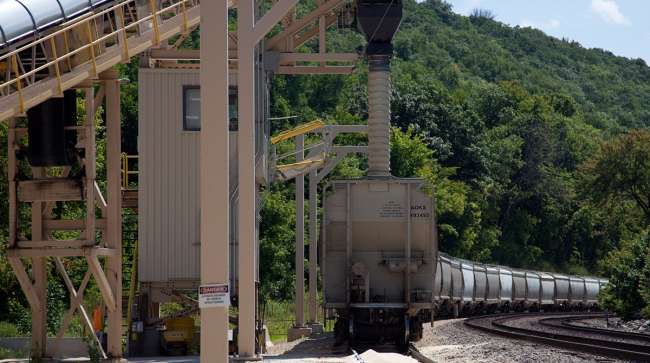Wisconsin Frac Sand Producers Seek Relief From Rail Costs, Service Issues

In a clash of old and new industries, Wisconsin frac sand producers say their business is threatened by a handful of railroads operating under outdated regulations. Wisconsin produces about a third of the nation’s supply of sand used to extract natural gas and oil through a process known as hydraulic fracturing, or “fracking.”
The dozens of mines that have sprung up across western Wisconsin in the past decade rely on four major railroads to deliver more than 30 tons a year of their “Northern White” product to wells in far-flung places such as Texas, North Dakota and Pennsylvania.
“We don’t do hydraulic fracturing in Wisconsin,” said Marty Lehman, spokesman for the Wisconsin Industrial Sand Association. “You’ve got to get the sand to where the need is. Trucking is not a cost-effective option.”
But those mines, strategically located along rail lines, are “practically held hostage” to whatever prices and services are offered by their rail carriers, according to a national trade organization.
“Overall rail service is declining significantly over the last several years,” said Chris Greissing, executive vice president of the Industrial Minerals Association-North America. “The pricing has soared.”
Indeed, in recent years the oil industry in Texas has begun to turn to new “in basin” sources, using lower quality sand mined near the wells to avoid shipping, which can account for up to 70% of the delivered cost of Wisconsin sand, according to industry analysts.
And frac producers say service problems — especially on the Canadian National line — seriously affected their business in the first part of this year.
This comes as domestic crude oil production is at an all-time high, driven largely by shale extraction made possible by fracking. Domestic production of silica sand last year was about 105 million tons, just shy of the all-time record, according to the U.S. Geological Survey, and analysts expect it will climb higher in the next two years.
Hi-Crush Partners, which operates four mines in Wisconsin, resorted to trucking sand from some mines to be loaded on trains at other sites, costing the company about $1.3 million in the first three months of the year.
CEO Robert Rasmus told analysts that the reduction in unit train availability also may have reduced sales by up to 500,000 tons of sand during the first quarter.
“The rail is a huge, huge issue,” said Kent Syverson, an industry consultant and chairman of the geology department at University of Wisconsin-Eau Claire.
Representatives of other companies are more reticent or declined to address the issue, which Greissing attributes to fear of being “blackballed” by their rail carriers.
“You have to have a very, very strong negotiating position if you’re going to win with the railroads,” Syverson said. “I don’t think a company would want to go up there and say many things.”
“This is an issue for just about anybody who moves a significant volume of anything by rail,” said Scott Jensen, a spokesman for the Rail Customer Coalition, a group of industry and agricultural associations. The alliance is putting pressure on the president and lawmakers to address problems that it says have grown in the nearly 40 years since Congress took steps to deregulate railroads through the Staggers Act.
Railroads are increasing rates and coming up with new ways to charge customers even as service has declined, he said. “It’s like a reverse of the Walmart tagline: pay more, get less.”
Jensen points to data showing the nominal cost per car nearly has doubled since the last railroad merger in 2001.
But that’s not the best measure of cost, according to the Association of American Railroads, which represents the nation’s largest rail carriers.
Adjusted for inflation, average revenue per ton-mile — the amount railroads charge for weight and distance — has increased by about a third over the same period and actually is 46% less than than in 1981.
AAR says the Staggers Act is working just fine and that the industry has invested more than $660 billion improving service and safety over the past four decades.
“The current balanced economic regulatory framework saved the rail industry from collapse nearly 40 years ago and continues to be a success,” AAR spokeswoman Jessica Kahanek said. “This regulatory structure protects railroad customers from unreasonable railroad actions while also allowing market forces and competition to determine rail rates.”
Tension between railroads and their customers is nothing new.
Frank Douma, a transportation researcher at the University of Minnesota’s Humphrey School of Public Affairs, said the current clash can be traced to Hunter Harrison, the late executive who turned around three railroads and established new benchmarks for lower operating costs.
“It really places a premium on being able to … have as lean an operation as possible,” Douma said. “That’s kind of become the darling measure of how railroads are performing. The customer groups have started to kind of say, now wait a minute, that tends to only look at one side of the equation.”
Besides rates and service, the Rail Customer Coalition would like regulators to require railroads to allow “competitive switching,” in which customers with access to only one railroad would be able to have their cargo transferred to another railroad within a certain distance.
Jensen said that would provide flexibility for producers trying to reach different markets and encourage cost competition by the railroads.
AAR calls this “forced access” and says it would “significantly compromise” the efficiency of the nation’s rail network.
“Large corporations dissatisfied that they have to pay fair-market rates to ship products are driving this proposal,” according to AAR. “Under the proposal, they could petition the STB, which in turn would force the railroad to hand over traffic to a competitor who would charge less.”
While U.S. Sen. Tammy Baldwin (D) has introduced a bill that would address some of RCC’s concerns, the coalition thinks many of these issues could be addressed by the Surface Transportation Board, which regulates commercial rates and operations.
The five-member board has been hamstrung by three vacancies, though two Republican nominees are awaiting confirmation by the Senate.
Distributed by Tribune Content Agency, LLC



